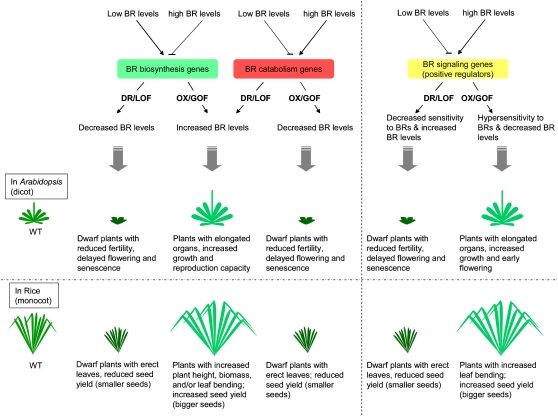Figure 1.
BR Homeostasis and Signaling Mechanisms and Their Effects on Plant Growth and Development in Arabidopsis (Dicot) and Rice (Monocot).
Low levels of BRs promote BR biosynthesis. Conversely, under high BR levels, the signaling of BRs is active and the synthesis of BRs is repressed through BR signaling–mediated transcriptional negative feedback regulation. Downregulation of BR biosynthetic enzymes or overexpression of BR inactivation enzymes leads to decreased levels of the end product of BR synthesis, whereas downregulation of the positive regulators or overexpression of the negative regulators of the BR signaling pathway also decreases BR levels as well as increasing the sensitivity to BRs. On the contrary, BR levels are increased by overexpression of a BR biosynthetic enzyme (rate-limiting step)/BR signaling positive regulator or by downregulation of a BR catabolic enzyme/BR signaling negative regulator. A decrease in plant endogenous BR levels generally results in dwarfism, shorter petiole (in Arabidopsis)/more erect leaves (in rice), and reduced fertility. By contrast, Arabidopsis or rice plants with increased endogenous BR levels generally display improved plant growth and reproduction capacity. To date, the impact of altering endogenous BR content on the plant tolerance to abiotic and biotic stresses remains unclear. DR, downregulation; GOF, gain of function; LOF, loss of function; OX, overexpression.

